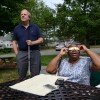Wisconsin’s primary, held in the midst of the coronavirus pandemic on Tuesday, portends serious trouble for the November elections that should give everyone pause. Democratic Governor Tony Evers’s belated attempt to postpone the event until June or make accommodations for universal mail-in ballots was blocked by the Republican-controlled state legislature, resulting in long lines and increased wait times as voters headed to the polls wearing whatever personal protective gear they could assemble. The effects of holding an in-person election during a time of crisis were not distributed equally. In Milwaukee, where the majority of the state’s African Americans reside, only five of 180 polling stations opened for business.
However, Wisconsin’s problem may soon be a national problem as the threat of a resurgent public health emergency looms over the constitutionally mandated elections approaching this fall. If Wisconsin’s experience gives us a preview of the future, we can expect the coronavirus to intersect with the voting wars that have plagued American electoral politics since the turn of the twenty-first century.
We are living through a historical period of unprecedented partisan balance in which Republicans and Democrats are near evenly matched. This stalemate raises the stakes of every election cycle, which could flip control of Congress or the White House. With this partisan parity as well as the stability of partisanship in the electorate, the overriding strategy has been to both expand or contract the voting population.
Due to compromise federal legislation and the independence of states to regulate their own elections, these expansions and contractions of the electorate have often occurred side by side.
On the one hand, under the aegis of the Help America Vote Act, passed in the wake of the contested 2000, a number of states have implemented more or less strict laws requiring voters to present government-issued photo ID when they vote. Designed with the purpose of preventing electoral fraud, critics have charged that such laws effectively disenfranchise poor and minority voters – a view that has been corroborated by some researchers.
While the Supreme Court upheld Indiana’s voter ID law in 2006, it was the Court’s revocation of the key enforcement mechanism of the Voting Rights Act in 2013 that seemed to constitute a turning point. Within 24 hours Texas, North Carolina, Mississippi, and Alabama all moved to implement stricter voter ID laws.
On the other hand, many states have moved to make their elections more accessible. This includes measures such as early voting, voting by mail (Oregon has moved entirely to mail-in ballots), generous absentee balloting, and Election Day registration.
If the November election takes place in the midst of a renewed concern for the coronavirus and perhaps even new shelter-in-place measures, we are likely to see an acceleration of these already-entrenched patterns. While no one endorses electoral corruption and no one disputes the value of a near-universal franchise, partisanship will likely be the guiding light as states and the federal government plan for a national election in the midst of a pandemic.
Minor differences in turnout can have significant effects on elections, especially when they are decided by such narrow margins. As we saw in Wisconsin, access to the ballot quickly became a partisan issue. If blue states move to adopt mail-in ballot procedures in the fall while red and purple states keep things status quo, we are likely to see not only diminished turnout, but a more unequal electorate as well. New, unfamiliar procedures, with or without extra steps – even if they are designed to enhance accessibility – often only advantage those who were already planning to vote.
COVID 19 may affect the outcome of this election. But it only highlights the ongoing struggle over the future of American democracy.
Adam Hilton (@adhilt) is assistant professor of politics at Mount Holyoke College.




